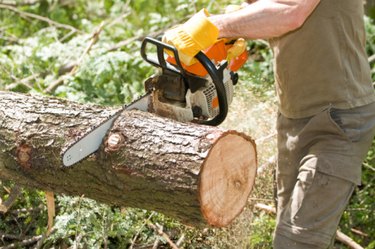
The chain saw is a marvelous and simple tool. Its introduction ended centuries of felling trees and cutting limbs and firewood with manual crosscut saws, often two-man devices that required both skill and strong physical exertion. A chain saw can now do in hours what would take a man a full day with a hand saw. Chain saws are simply an engine which turns a sprocket that drives a chain around a fixed bar. Sharp teeth on the chain slice through the wood.
Three Types of Cut
Video of the Day
There are three basic types of cutting with a chain saw: felling, which is dropping trees to the ground; cutting, which is dividing the felled tree into smaller units; and limbing, which is cutting off limbs and branches from standing or felled trees. Cut with the bar vertical, pressing down into the log; never cut up with the top of the chain. For felling, cut with the bar horizontal, with the saw turned on its side.
Video of the Day
Cut Limbs and Branches
You should always cut low limbs and branches before felling a tree. Never cut with the saw above your shoulder height. Very tall trees may require a ladder to reach limbs; always climb the ladder with the saw turned off, then start it once you are securely placed on the ladder. Cut branches and limbs with a downward stroke of the saw, as close as possible to the main trunk. Remove small branches from big limbs before cutting the limbs. Always use a vertical cut.
Felling a Tree
Felling a tree requires three cuts. The first is a diagonal directional cut on the side of the tree where you want it to fall. Hold the saw at about a 45-degree angle and cut downward. Run the saw at full power and do not let the chain bind. Make the second, a bottom cut, horizontally to intersect with the directional cut and remove a triangle from the tree. Move to the other side of the tree and make the felling cut, which is horizontal a couple of inches above the level of the bottom cut. The tree should fall when the felling cut meets the directional cut; if the saw starts to bind, remove it and drive a wedge into the felling cut to force the tree to fall.
Lift the Trunk for Cuts
Cut the felled tree into sections by first trimming off all of the limbs and branches. Raise the trunk onto a support, if possible, and cut the unsupported sections in blocks. If the trunk is too long or large to raise, cut halfway through it at the dividing points, then roll it over and finish cutting from the other side of the trunk.
Wear Safety Gear
Always wear gloves, a hard hat and goggles when felling or cutting trees; put on leather chaps or leg protection if possible. Clear the area of obstructions or limbs that might cause you to trip while working. Turn the saw off before moving through limbs and other debris. Never let the saw cut into the ground; stop it and turn the log if necessary.